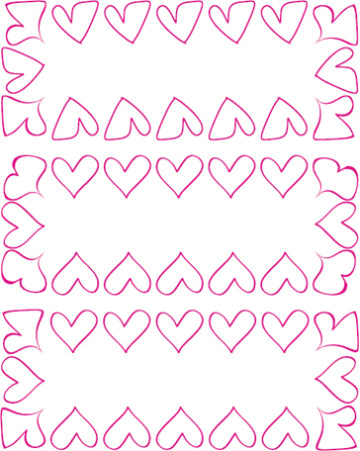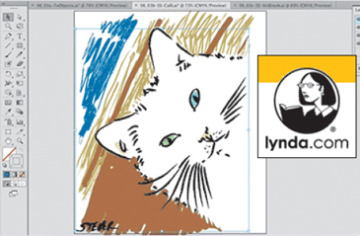- Width Tool And Stroke Profiles
- The Expanded Stroke Panel
- Brushes
- Symbols
- Dynamic Symbols, & New Raster Brushes in CC
- Stroke Variance
- Gallery: MCKIBILLO (AKA Josh McKible)
- Brushes & Washes
- Gallery: Stephen Klema’s Students: Jillian Winkel, Stephanie Pernal, Amber Loukoumis, Jeffrey Martin, Nicole Dzienis, Tamara Morrison
- Gallery: Sharon Steuer
- Painting Inside
- Painterly Portraits
- Gallery: Greg Geisler
- Pattern Brushes
- Gallery: Donal Jolley
- Brush Corners
- Gallery: Lisa Jackmore
Dynamic Symbols, & New Raster Brushes in CC
Dynamic Symbols
With the addition of Dynamic symbols, you can now edit some aspects of a symbol’s appearance without using symbolism tools and without breaking the link to the original symbol. Because you can edit individual objects within a dynamic symbol instance, including Stroke, Fill, Opacity, and Live Effect, without needing to save yet new symbols for every minor variation, Dynamic symbols are more efficient than Static symbols. If you change the original symbol in some fashion, all the other instances will update to reflect the change except each instance’s local overrides: However, you can’t edit the shape (path or live shape attributes) of a symbol instance. Use the Direct Selection tool to select the symbol instance, or part of it, that you want to edit. The Selection tool selects the entire symbol for transforming and the appearance can’t be modified, so click away from the symbol to deselect it if necessary, then click back with the Direct Selection tool. A thick outline lets you know that the object is selected and ready for editing. Edit the appearance of the object as desired and click outside the symbol again to deselect it.
Raster image brushes
Art, pattern, and scatter brushes have been supercharged. Finally you can use embedded raster artwork in the brushes you create, and you can mix raster with vector in the same brush. You’ll find several examples of raster brush art in this chapter, but keep in mind the following points when creating brushes from raster artwork:
Limit the size (in pixels) for pattern and art brushes to approximately one megapixel, though scatter brushes can be any size, although performance can slow down. Because the brush’s redraw performance lags with larger brushes, Illustrator will offer to “optimize” (down sample) any single raster object (the copy it uses, not the original) that exceeds that limit. Illustrator can’t downsample multiple objects, and may not be able to downsample very large images either. You’ll see a warning to resize the artwork before creating the brush, at which point you can choose Object> Rasterize to downsample your image. Illustrator downsamples the image to match the size of the image on the artboard at the resolution you choose in the dialog. It may be enough simply to scale the image before rasterizing, or it might also require rasterizing at a lower resolution, depending upon the size you’re starting with. With some artwork, you may be able to reduce the size of your raster image by cropping the image before making the artwork into a brush using Image Crop; for more details about Image Crop, see the CC section of the Creatively Combining Apps introduction. (Also see the Tip “How big is a megapixel” at left for help figuring out if your artwork is within parameters.)
To maintain the quality of your artwork, create the brush as close to the size you need as possible. Brushes from raster artwork are pixel based, not vector, even if they include vector in them, and will degrade if significantly scaled. To ensure that you can access the original artwork, or to re-rasterize it at another resolution, it’s best to always rasterize a copy of your object.
Distortion affects rasters, and if you bend pixels along a path, as is common with art brushes, the artwork has to be interpolated. Some distortion can be too extreme for Illustrator to fill in the gaps. There’s a significant difference between choosing Stretch to Fit and Scale Proportionally with art brushes, so experiment to get the results you want when working with images in your brushes.
With a pattern brush, if your art isn’t oriented properly to the path, you must rotate it first on the artboard. You should note that although you can change the orientation of your artwork in the Art Brush Options dialog, Illustrator doesn’t always rotate large or complex raster art correctly. To avoid difficulty, rotate the artwork on the artboard before attempting to create the brush.
Raster portions of brushes can’t be colorized. Changing the Colorization settings in the Brush Options dialog won’t have any effect on the raster portions of your brush, only vector elements (see Sharon Steuer’s “shell” gallery later in this section for an example of this).

SHARON STEUER (From Her “Artistic Painting With Illustrator” Course On Lynda.Com
In this example from Sharon Steuer’s “Artistic Painting with Illustrator” course on lynda.com, she liked the auto-corner generated by her heart pattern (top) better than the auto-corner generated by the “fixed” heart pattern (middle); for the final she manually replaced the “fixed” auto-corner with the one generated by the original (see Lisa Jackmore’s “Castle Brush” gallery later in this chapter for details on how to do this)
Corner tiles for pattern brushes
Corner tiles have been a stumbling block for many of us when we create pattern brushes. Illustrator CC has partially addressed the problem by providing auto-generated corner tiles. Whenever you create a side tile for a pattern brush, you can click the down arrow beside an inner or outer corner tile field and choose from four tiles that Illustrator generates: Auto-Centered, Auto-Between, Auto-Sliced, and Auto-Overlap.
Plus, if you like an auto-generated corner, you can reuse it as a corner for another pattern by dragging it out of one brush and into another (see the “Hearts” example at left). See Lisa Jackmore’s “Castle Brush” in the CC gallery section later in this chapter to learn how to extract a corner for use with another brush.
When one of these auto-generated corners works for the brush, you don’t have to do anything more than choose it for your corner(s), but if it isn’t quite right, you still either edit the corner or create a corner from scratch. You can also simply try eliminating the corners, rounding the path instead (see Sharon Steuer’s “Paper Dolls” in the CC gallery section later in this chapter). You can find more examples of rasters in brushes, as well as more about auto-corners, in the lessons and galleries both in the CC section at the end of this chapter and in the CC section at the end of the Mastering Complexity chapter.
Another small change to be aware of is that in the Pattern Brush Options dialog, the individual pattern tiles that together define the behavior of a pattern brush are ordered differently than they were in CS6.


